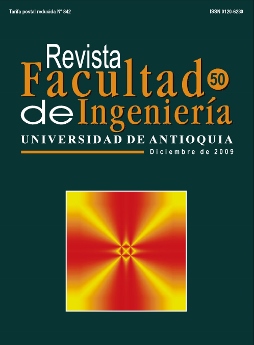Seguimiento de trayectorias y objetivos en tierra usando un dirigible y visión artificial
DOI:
https://doi.org/10.17533/udea.redin.14938Keywords:
Robótica móvil, dirigible, visión artificial, seguimiento de trayectorias, seguimiento de objetivosAbstract
Este artículo presenta un sistema robótico autónomo compuesto por un dirigible para interiores, un sistema de vídeo inalámbrico, un PC y una aplicación para el seguimiento de trayectorias y objetivos en tierra con alto contraste. Se ha simplificado el modelo del dirigible con el fin de obtener su modelo lineal, con el cual se han definido objetivos de control como la orientación relativa del dirigible y la distancia de éste a objetivos en tierra. Se ha diseñado una estrategia de control PD tanto para la orientación como para la distancia a los objetivos, alcanzando un tiempo de estabilización de 5s y un sobre-impulso de 5%. La cámara es el único sensor de realimentación, cuyas imágenes son procesadas para: la segmentación de trayectorias, usando la transformada de Hough, el operador de Canny y un filtro mediana; la segmentación de objetos en tierra, usando diferenciación por color en HSI. Se realizaron pruebas para el seguimiento de trayectorias lineales, curvas y una combinación de ellas, arrojando errores de orientación inferiores a ±14º y distancia de ±5pixeles. Se realizaron pruebas para el seguimiento de objetivos en tierra, describiendo trayectorias lineales y curvas, arrojando errores de distancia de ±39 pixeles que corresponden al 8,33% de las dimensiones de la imagen y orientación enel sentido del objetivo de ±12º.
Downloads
References
Airship. Airship Launches the First End-to-End Video Surveillance Platform. http://www.airshipdvr.com/
enterprise_video_surveillance.html. Consultada el 15 de septiembre 2008.
G. Kantor, D. Wettergreen, J. Ostrowski, S. Singh. “Collection of Environmental Data From an Airship Platform”. Proceedings of the SPIE Conference on Sensor Fusion and Decentralized Control IV. Bellingham. WA. Vol. 4571. 2001. pp. 76-83. DOI: https://doi.org/10.1117/12.444171
Science Daily. Purdue Team to Float High Altitud Airship for Weather Security. http://www.sciencedaily.
com/releases/2005/03/050329135943.htm. Consultada el 12 de septiembre 2008.
S. Lacroix. Toward Autonomous Airships: Research and Developments at LAAS/CNRS. France, Internal
Report, LAAS / CNRS. 2000. pp. 3-9.
P. R. Newswire Europe Ltda. Optus Trials IT IS Cellular Floating Vehicle Data Technology in Sydney Australia. http://www.prnewswire.co.uk/cgi/news/release?id=184712. Consultada: el 2 de octubre 2008.
N. Simmons, G. Gates, J. Burr. “Commercial Applications Arising from a Floating Vehicle Data System in Europe”. 9 World Congress on Intelligent Transport Systems. London. U.K. 2006. pp. 2-8.
El Espectador. Agencia EFE. “Este Año se han Robado más de 6000 Carros”. http://www.elespectador.com/noticias/nacional/articulo-ano-se-han-robado-mas-de-6000-carros Consultada el 14 de septiembre de 2008.
Redacción, El Periódico. “Cada día 52 Carros son Robados en Colombia”, http://www.elperiodico.com.
co/seccion.php?codigo=13113&seccion=1&fecha=2008-09-01. Consultada el 15 de octubre 2008.
J. Craig. Introducción a la Robótica. 2ª ed. Pearson Educación. México. 2006. pp. 19-180.
T. Fossen. Guidance and Control of Ocean Vehicles. John Wiley & Sons. 2003. pp. 5-353.
H. Goldstein. Mecánica Clásica. Editorial Reverté. Madrid. 1996. pp. 34-238.
S. Van der Zwaan. Vision Based Station Keeping and Docking for Floating Robots. Msc. Thesis. Instituto Superior Técnico. Lisboa. 2001. pp. 47-61. DOI: https://doi.org/10.23919/ECC.2001.7076375
S. B. V. Gomes. J. G. Ramos. “Airship dynamic modeling for autonomous operation,” Proceedings IEEE International Conference on Robotics and Automation. Leuven. Belgium. 1998. Vol.4. pp. 3462- 3467
F. Da Silva, L. García. Vision Based Control of an Autonomous Blimp, Universidad Técnica de Lisboa. Instituto Superior Técnico. Lisboa. 2003. pp. 3-67.
O. Katsuhiko. Sistemas de Control en Tiempo Discreto. 2a ed. Ed. Prentice – Hall. New Jersey. 1996. pp. 173-474.
R. Gonzales. R. E Woods. Tratamiento Digital de Imágenes. Ed. Addison-Wesley Iberoamericana. Wilmington. 1996. pp. 1-773.
Downloads
Published
How to Cite
Issue
Section
License
Copyright (c) 2018 Revista Facultad de Ingeniería

This work is licensed under a Creative Commons Attribution-NonCommercial-ShareAlike 4.0 International License.
Revista Facultad de Ingeniería, Universidad de Antioquia is licensed under the Creative Commons Attribution BY-NC-SA 4.0 license. https://creativecommons.org/licenses/by-nc-sa/4.0/deed.en
You are free to:
Share — copy and redistribute the material in any medium or format
Adapt — remix, transform, and build upon the material
Under the following terms:
Attribution — You must give appropriate credit, provide a link to the license, and indicate if changes were made. You may do so in any reasonable manner, but not in any way that suggests the licensor endorses you or your use.
NonCommercial — You may not use the material for commercial purposes.
ShareAlike — If you remix, transform, or build upon the material, you must distribute your contributions under the same license as the original.
The material published in the journal can be distributed, copied and exhibited by third parties if the respective credits are given to the journal. No commercial benefit can be obtained and derivative works must be under the same license terms as the original work.










 Twitter
Twitter